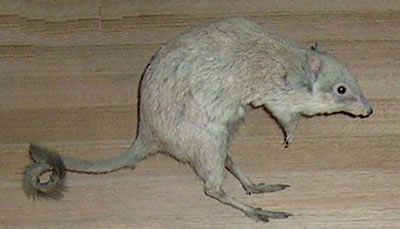Woylie

Facts about creatures
- Home
- Animal Classification
- Animal Habitats
- Amphibians
- Arthropods
- Bats
- Birds
- Carnivorans
- Cetaceans
- Chordates
- Crustaceans
- Dinosaurs
- Diprotodonts
- Elephants
- Fish
- Golden Mole
- Insects
- Lagomorphs
- Mammals
- Mammal Teeth
- Marsupial Mole
- Metamorphosis
- Mollusks
- Primates
- Reptiles
- Rodents
- Ruminants
- Soricomorphans
- Tenrec
- Tetrapods
- Vertebrates
Woylie
The woylie, also known as the brush-tailed bettong or the brush-tailed rat kangaroo, has a prehensile tail – a tail that can grab and hold things.
It uses its tail to carry bundles of grass and twigs to its nesting site, then uses them to make a bed.
Woylies have gray and brown fur. They are about a foot tall, and weigh between about 2 and 3 ½ pounds.
Their front legs are strong and useful for digging.

The woylie is a nocturnal (active at night), solitary animal.
Its diet mostly consists of fungi. Bacteria in the woylie’s stomach eat the fungi, and then produce nutrients that are digested by the woylie.
Woylies also eat seeds, bulbs, roots, tubers, resins and insects.
Native to Australia, the woylie is a critically endangered species.
Foxes that were brought to Australia hunted woylies until the woylies almost became extinct.
In the 1980s and 1990s, the government set up programs to poison foxes in areas where woylies lived. Many foxes died and the woylie population increased. (The woylies were immune to the poison that was used.)
However, the decline of the fox population led to an increase in the feral cat population. Feral cats prey on woylies, and they have caused the woylie population to decline once more.
Scientists also think that many woylies have died from diseases.